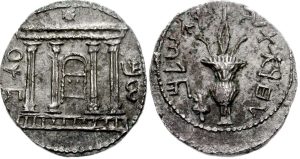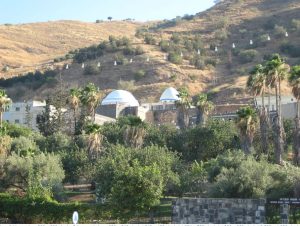While discussing the scroll that is put in the Sotah waters, the Gemara brings an interesting digression, one where we learn both the profession and the teachers of one of our most important Tannaim, Rabbi Meir.
“Rav Yehuda says that Shmuel says in the name of Rabbi Meir: When I was studying Torah before Rabbi Akiva , I used to put iron sulfate into the ink and he did not say anything to me. Afterward, when I came to learn Torah before Rabbi Yishmael, he said to me: My son, what is your vocation? I said to him: I am a scribe [lavlar] . . ” (Sotah 20a)
Rabbi Meir, like many of the sages, worked for a living and did not depend upon his scholarship for a livelihood. He was a scribe, a respected profession, here called a lavlar. His professional knowledge helps us understand the requirements of the Sotah scroll – he put a special ingredient in to make the ink permanent but Rabbi Yishmael taught him that for the Sotah the ink had to be able to be erased.
But perhaps even more interesting than this inside scribal knowledge is the offhand remark that Rabbi Meir studied with both Rabbi Yishmael and Rabbi Akiva. These were the preeminent teachers of the age and through them Rabbi Meir absorbed much of the knowledge and traditions of the Tannaim. This is extremely important since Rabbi Meir was one of the few teachers and ordained rabbis to survive the Bar Kokhba Revolt. As we have often seen in these pieces, the Revolt decimated the Torah world of the time and the survivors had the responsibility to rebuild and teach anyone they could. Rabbi Meir and his wife Bruria were two of those survivors.

A Bar Kokhba coin
Classical Numismatic Group, Inc. http://www.cngcoins.com, CC BY-SA 3.0 <http://creativecommons.org/licenses/by-sa/3.0/>, via Wikimedia Commons
Rabbi Meir and Bruria would have been called a power couple if they had used that phrase in the old days. Both of them were scholars and both of them were as schooled in tragedy as in Torah. They survived the Bar Kokhba Revolt with terrible scars. Rabbi Meir lost one teacher, Rabbi Akiva, to martyrdom, and another, Elisha ben Abuya, to apostasy. Rabbi Yishmael, as well as many more from that generation, were also murdered by the Romans. Bruria’s father Rabbi Chananya ben Teradion was burnt alive with a Torah scroll as she watched, her mother was murdered as well and her sister was captured and forced to work in a brothel until Rabbi Meir freed her. As a family they lost their two sons on the same day. And yet they are famous for their knowledge and their compassion for saints and sinners alike.
Rabbi Meir was one of the students who carried on the torch of Rabbi Akiva’s learning and in fact the Gemara in Sanhedrin states that any unattributed mishnah (סתם משנה) comes from the teachings of Rabbi Meir (Sanhedrin 86a). He continued to learn from his wayward teacher Elisha ben Abuya despite the latter’s having left the world of Judaism. If you find a pomegranate, eat the seeds and throw the rest away was how Rabbi Meir phrased it; take the good and leave behind the rest. Until Elisha’s last day Rabbi Meir pleaded with him to repent and not give up hope for a better world.
The Gemara in Eruvin acknowledges the brilliance of Rabbi Meir and questions why we do not adjudicate the halacha according to his opinion. The answer is that he saw too many sides to one question:
“Rabbi Aḥa bar Ḥanina said: It is revealed and known before the One Who spoke and the world came into being that in the generation of Rabbi Meir there was no one of the Sages who is his equal. Why then didn’t the Sages establish the halakha in accordance with his opinion? It is because his colleagues were unable to ascertain the profundity of his opinion.” (Eruvin 13b)
Rabbi Meir was so intellectually honest that he had to show how each side could be right. Perhaps his colleagues, less brilliant than he, sought more clarity and less depth. In any case he was considered to be one of the most incisive of the scholars. On that same page, Rabbi Judah the Prince says that his own sharp intellect stems from the fact that he sat behind Rabbi Meir; how much smarter would he be if he had sat in front of him!
Rabbi Meir had a fitting life partner in his wife Bruria, a daughter of a famous Torah scholar and a scholar herself. Bruria was acknowledged for her Torah in a world were women were considered incapable of higher learning. She also had deep respect for her husband and tried to break the news of their sons’ deaths as easily as possible by telling him a parable about having received a gift to watch that had to be returned eventually. She also urged him to have mercy on sinners and pray for them to repent rather than for them to disappear.
Rabbi Meir lived and taught in Hamat Tverya, the ancient city with hot springs adjacent to Tverya and today within its boundaries. One of the famous stories about him (told in the Yerushalmi, Sotah 1:4) relates how he would teach on Friday nights and a certain woman would always come to listen to the sermon. One week he spoke for longer than usual and when she came home her husband was angry that the lights had gone out and the food was cold. He forbade her to return until she had spit in the teacher’s eye. Rabbi Meir heard about the decree and summoned the woman to come and heal him from an eye ailment by spitting in his eye, thereby fulfilling the will of the husband while saving the wife from shame at disrespecting her teacher.

The mosaic floor in the ancient synagogue of Hamat Tverya
Bukvoed, CC BY 3.0 <https://creativecommons.org/licenses/by/3.0>, via Wikimedia Commons
The world of survivors that Rabbi Meir and Bruria were part of could not afford to lose any Jewish soul. So many had been lost already. These stories, about Elisha and about the sinners, about the angry man and his wife, share a common thread. All need to be reconciled back to the Jewish faith so that we can rebuild together.
Right up the hill from the synagogue is the largest and most famous gravesite in Tverya, Kever Rabbi Meir Baal HaNes. Is this our Rabbi Meir? Maybe, could be, probably not. No matter, people have been coming to pray here for all sorts of salvations and miracles for hundreds of years. In fact, Rabbi Meir Baal HaNes became the patron saint of Tverya and his tomb was featured on the charity boxes distributed throughout the Diaspora, Kupat Rabbi Meir Baal HaNes. In return for donations, Rabbi Meir would find your lost items and heal you. Rabbi Meir became the fundraiser and PR man for Tverya posthumously. However, his legacy is much greater than that. He helped to bring Torah learning back to life in a world where it had been decimated.

The tomb of Rabbi Meir Baal HaNes in Tiberias
Eliyahu (Eli), CC BY-SA 3.0 <https://creativecommons.org/licenses/by-sa/3.0>, via Wikimedia Commons
The name Meir means to light up, and the Gemara also gives him an Aramaic equivalent, Nehorai. Rabbi Meir and Bruria worked to being light into a world that had been darkened by tragedy.










